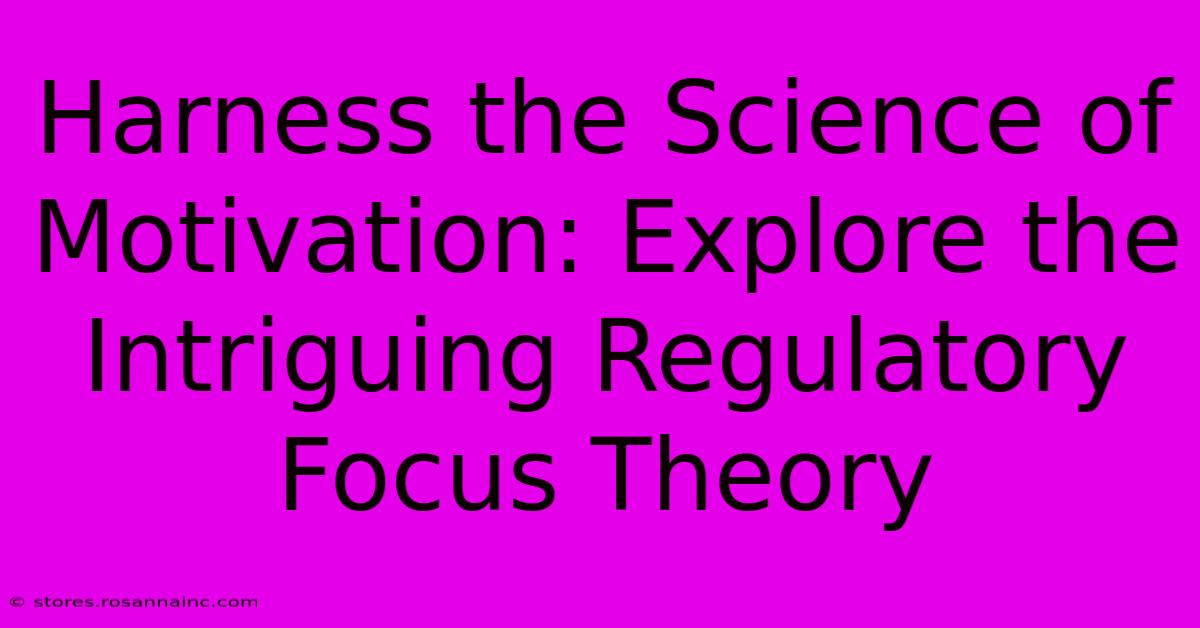Harness The Science Of Motivation: Explore The Intriguing Regulatory Focus Theory

Table of Contents
Harness the Science of Motivation: Explore the Intriguing Regulatory Focus Theory
Motivation—the driving force behind our actions—is a complex tapestry woven from various psychological threads. Understanding what fuels our behavior is crucial, whether you're aiming for personal growth, managing a team, or simply navigating daily life. One particularly insightful theory that sheds light on this complexity is Regulatory Focus Theory (RFT). This article dives deep into RFT, exploring its core principles, practical applications, and how you can harness its power to achieve your goals.
Understanding Regulatory Focus Theory
Developed by renowned psychologists Tory Higgins and colleagues, RFT proposes that individuals pursue goals through two distinct yet complementary motivational orientations: promotion focus and prevention focus. These aren't mutually exclusive; rather, they represent different ways of approaching goals and responding to feedback.
Promotion Focus: Striving for Gains
Individuals with a promotion focus are driven by the desire for advancement and growth. They focus on ideals, aspirations, and achieving positive outcomes. Think of it as a "growth mindset" in action. Key characteristics of a promotion focus include:
- Approach Motivation: Actively seeking opportunities and challenges.
- Ideal Self-Focus: Concentrating on achieving desired states and experiences.
- Positive Emotions: Experiencing joy and excitement upon success.
- Risk-Taking: Embracing challenges even with the potential for failure.
Example: A student with a promotion focus would aim for high grades to achieve academic excellence and personal fulfillment.
Prevention Focus: Striving to Avoid Losses
In contrast, a prevention focus prioritizes security and the avoidance of negative outcomes. Individuals with a prevention focus emphasize responsibility, duty, and avoiding mistakes. Their focus is on maintaining a stable and safe state. Characteristics include:
- Avoidance Motivation: Working to prevent setbacks and failures.
- Ought Self-Focus: Concentrating on fulfilling obligations and avoiding undesirable states.
- Negative Emotions: Experiencing relief from avoiding negative outcomes.
- Risk Aversion: Opting for safer, more predictable choices.
Example: The same student, with a prevention focus, would strive to avoid failing grades to maintain their academic standing and avoid disappointing their parents.
The Power of Balance: Optimizing Your Regulatory Focus
While both promotion and prevention focuses are essential for successful goal pursuit, the optimal balance between the two is key. An exclusive reliance on either can lead to limitations. For instance:
- Overemphasis on Promotion Focus: Can lead to excessive risk-taking, disappointment with setbacks, and decreased persistence in the face of obstacles.
- Overemphasis on Prevention Focus: Can result in missed opportunities, inhibited creativity, and a lack of ambition.
The ideal approach often involves strategically shifting between these orientations depending on the specific goal and context.
Practical Applications of Regulatory Focus Theory
RFT's implications extend far beyond academic discussions; its principles can be practically applied in various areas:
1. Goal Setting and Achievement:
Tailoring your approach to a goal based on its nature is crucial. For instance, a challenging, creative task might benefit from a promotion focus, while a task requiring precision and accuracy might benefit from a prevention focus.
2. Leadership and Management:
Understanding the regulatory focus of your team members enables more effective communication and motivation strategies. Tailoring feedback and rewards to align with individual orientations can significantly improve performance.
3. Marketing and Advertising:
RFT guides the design of effective marketing campaigns. Advertisements emphasizing positive outcomes and aspirations appeal to promotion focus, while those highlighting risk avoidance and safety appeal to prevention focus.
4. Personal Development:
By consciously shifting your focus, you can cultivate a more balanced and resilient approach to challenges. Self-awareness of your predominant regulatory focus is the first step towards optimizing your performance.
Conclusion: Embracing the Power of Dual Motivation
Regulatory Focus Theory provides a powerful framework for understanding the complexities of motivation. By recognizing the distinct roles of promotion and prevention focus and striving for a balanced approach, individuals and organizations can unlock their full potential and achieve lasting success. Integrating RFT's principles into your daily life, whether in personal or professional settings, can lead to more effective goal pursuit and a more fulfilling journey toward achieving your aspirations. Remember that understanding your own regulatory focus and adapting your strategies accordingly is key to harnessing the power of motivation.

Thank you for visiting our website wich cover about Harness The Science Of Motivation: Explore The Intriguing Regulatory Focus Theory. We hope the information provided has been useful to you. Feel free to contact us if you have any questions or need further assistance. See you next time and dont miss to bookmark.
Featured Posts
-
From The Silver Screen To Your Kitchen Discover The Enchanting Appeal Of Big Chill Appliances
Feb 06, 2025
-
Spread Holiday Cheer And Strengthen Customer Loyalty With Custom Business Cards
Feb 06, 2025
-
Unlock The Secrets Of The Ancients Gold Pendant Necklaces As Artifacts Of Timeless Tradition
Feb 06, 2025
-
The Pom Pom Revolution Discover The Versatility Of This Adorable Floral Trend
Feb 06, 2025
-
Stop Ear Infections Before They Start Your Guide To Finding An Expert Ear Doctor
Feb 06, 2025
